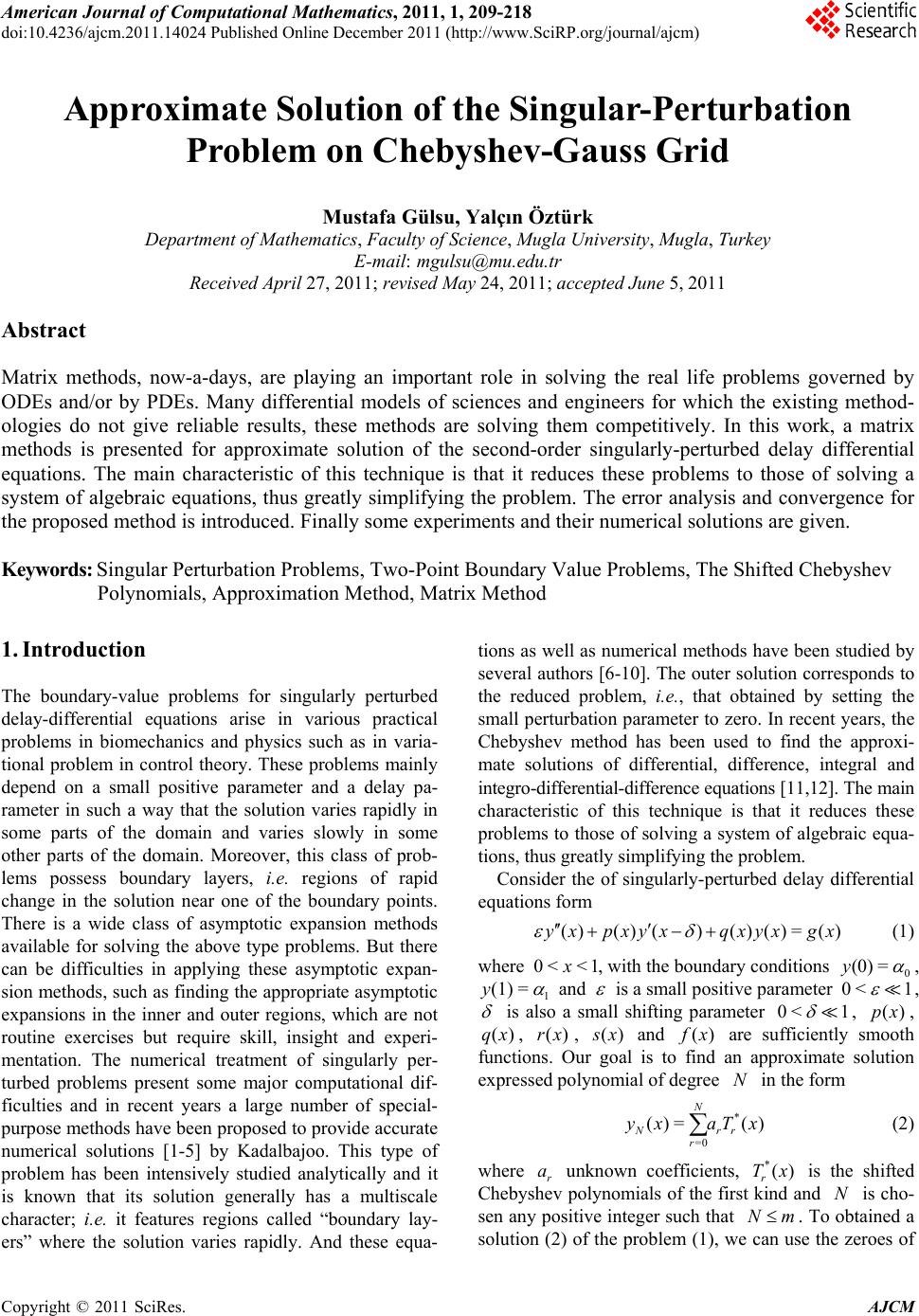 American Journal of Computational Mathematics, 2011, 1, 209-218 doi:10.4236/ajcm.2011.14024 Published Online December 2011 (http://www.SciRP.org/journal/ajcm) Copyright © 2011 SciRes. AJCM Approximate Solution of the Singular-Perturbation Problem on Chebyshev-Gauss Grid Mustafa Gülsu, Yalçın Öztürk Department of Mathematics, Faculty of Science, Mugla University, Mugla, Turkey E-mail: mgulsu@mu.edu.tr Received April 27, 2011; revised May 24, 2011; accepted June 5, 2011 Abstract Matrix methods, now-a-days, are playing an important role in solving the real life problems governed by ODEs and/or by PDEs. Many differential models of sciences and engineers for which the existing method- ologies do not give reliable results, these methods are solving them competitively. In this work, a matrix methods is presented for approximate solution of the second-order singularly-perturbed delay differential equations. The main characteristic of this technique is that it reduces these problems to those of solving a system of algebraic equations, thus greatly simplifying the problem. The error analysis and convergence for the proposed method is introduced. Finally some experiments and their numerical solutions are given. Keywords: Singular Perturbation Problems, Two-Point Boundary Value Problems, The Shifted Chebyshev Polynomials, Approximation Method, Matrix Method 1. Introduction The boundary-value problems for singularly perturbed delay-differential equations arise in various practical problems in biomechanics and physics such as in varia- tional problem in control theory. These problems mainly depend on a small positive parameter and a delay pa- rameter in such a way that the solution varies rapidly in some parts of the domain and varies slowly in some other parts of the domain. Moreover, this class of prob- lems possess boundary layers, i.e. regions of rapid change in the solution near one of the boundary points. There is a wide class of asymptotic expansion methods available for solving the above type problems. But there can be difficulties in applying these asymptotic expan- sion methods, such as finding the appropriate asymptotic expansions in the inner and outer regions, which are not routine exercises but require skill, insight and experi- mentation. The numerical treatment of singularly per- turbed problems present some major computational dif- ficulties and in recent years a large number of special- purpose methods have been proposed to provide accurate numerical solutions [1-5] by Kadalbajoo. This type of problem has been intensively studied analytically and it is known that its solution generally has a multiscale character; i.e. it features regions called “boundary lay- ers” where the solution varies rapidly. And these equa- tions as well as numerical methods have been studied by several authors [6-10]. The outer solution corresponds to the reduced problem, i.e., that obtained by setting the small perturbation parameter to zero. In recent years, the Chebyshev method has been used to find the approxi- mate solutions of differential, difference, integral and integro-differential-difference equations [11,12]. The main characteristic of this technique is that it reduces these problems to those of solving a system of algebraic equa- tions, thus greatly simplifying the problem. Consider the of singularly-perturbed delay differential equations form ()() ()()()=()yx pxyxqxyxgx (1) where 0< <1 , with the boundary conditions 0 (0) =y , 1 (1) =y and is a small positive parameter 0< 1 , is also a small shifting parameter 0< 1 , , , , ()px ()qx ()rx () x and () x are sufficiently smooth functions. Our goal is to find an approximate solution expressed polynomial of degree in the form N * =0 ()= () N Nrr r yx aTx (2) where r unknown coefficients, is the shifted Chebyshev polynomials of the first kind and is cho- sen any positive integer such that . To obtained a solution (2) of the problem (1), we can use the zeroes of a*() r Tx Nm N 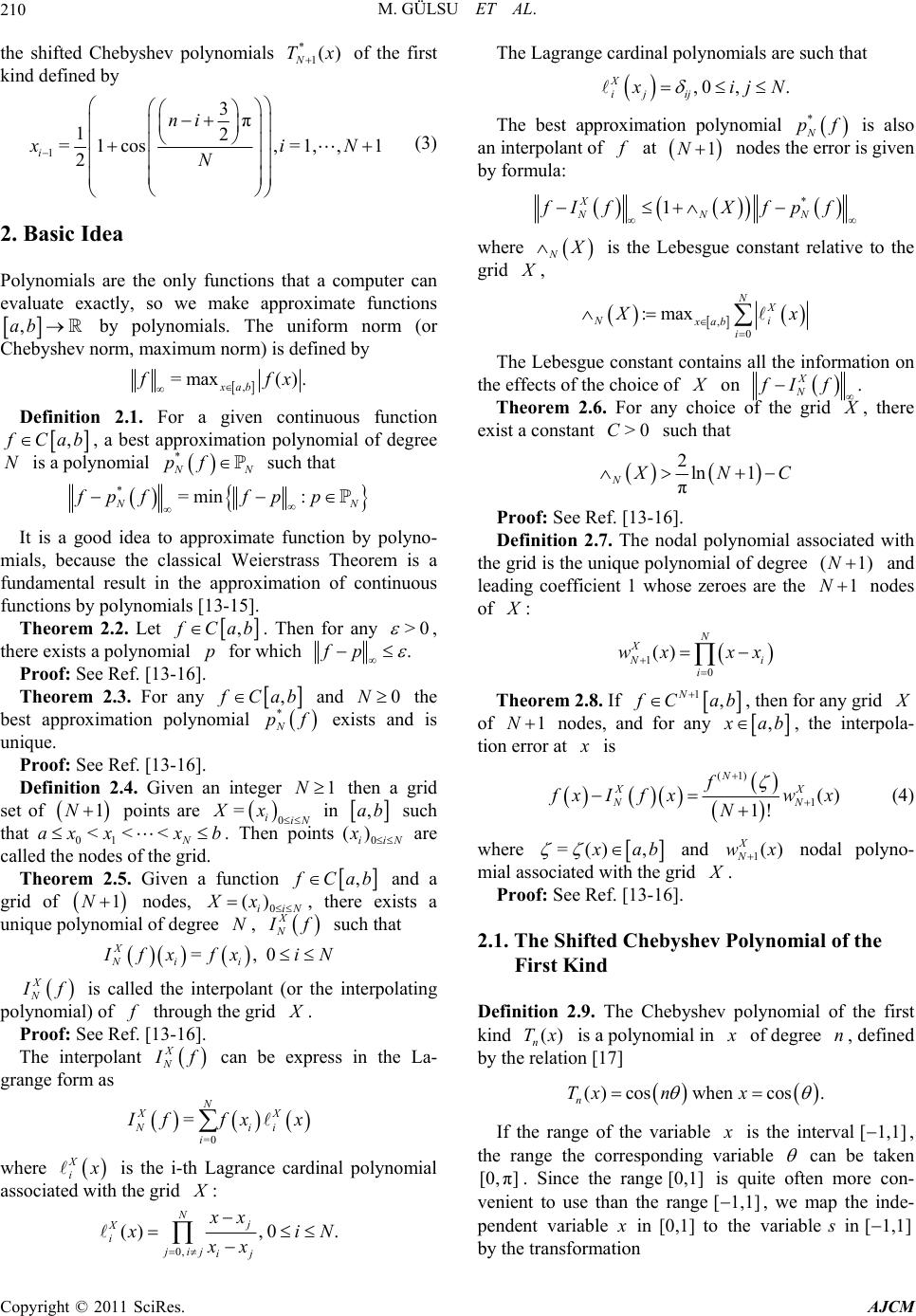 M. GÜLSU ET AL. 210 the shifted Chebyshev polynomials of the first kind defined by * 1() N Tx 1 3π 12 =1cos ,=1,, 1 2 i ni xiN N (3) 2. Basic Idea Polynomials are the only functions that a computer can evaluate exactly, so we make approximate functions ,ab by polynomials. The uniform norm (or Chebyshev norm, maximum norm) is defined by , =max xab ( ). fx Definition 2.1. For a given continuous function , Cab N , a best approximation polynomial of degree is a polynomial * N pf such that *=min : N fpffp p It is a good idea to approximate function by polyno- mials, because the classical Weierstrass Theorem is a fundamental result in the approximation of continuous functions by polynomials [13-15]. Theorem 2.2. Let , Cab. Then for any >0 , there exists a polynomial for which p.fp Proof: See Ref. [13-16]. Theorem 2.3. For any , Cab and the best approximation polynomial 0N * N pf exists and is unique. Proof: See Ref. [13-16]. Definition 2.4. Given an integer then a grid set of points are 0iN in 1N 1N =i Xx ,ab 0 () ii x such that 01 . Then pointsare called the nodes of the grid. <<< N xax xbN Theorem 2.5. Given a function , Cab N and a grid of nodes, 1N 0 () ii Xx , there exists a unique polynomial of degree , NN X f such that =,0 Ni i X fx fxiN X N f is called the interpolant (or the interpolating polynomial) of through the grid . Proof: See Ref. [13-16]. The interpolant X N f can be express in the La- grange form as =0 = N XX Ni i i ffx x where X i is the i-th Lagrance cardinal polynomial associated with the grid : 0, (),0. Nj X i jij ij x iN xx The Lagrange cardinal polynomials are such that ,0 ,. X ij ij ij N The best approximation polynomial * N pf is also an interpolant of at 1N nodes the error is given by formula: * 1 X NNN If Xfpf where N is the Lebesgue constant relative to the grid , ,0 :max NX Ni xab i x The Lebesgue constant contains all the information on the effects of the choice of on . X N fI f Theorem 2.6. For any choice of the grid , there exist a constant such that >0C 2ln 1 π N NC ) Proof: See Ref. [13-16]. Definition 2.7. The nodal polynomial associated with the grid is the unique polynomial of degree (1N and leading coefficient 1 whose zeroes are the 1N nodes of : 1 0 () N X i i wx xx Theorem 2.8. If 1, N Cab , then for any grid 1Nof nodes, and for any , ab, the inrpola- tion error at te is (1) 1() 1! N XX NN f xI fxwx N (4) where =() , ab and nodal polyno- mial associated with the grid 1() X N wx . Proof: See Ref. [13-16]. 2.1. The Shifted Chebyshev Polynomial of the First Kind Definition 2.9. The Chebyshev polynomial of the first kind is a polynomial in () n Tx of degree , defined by the relation [17] n ( )coswhencos. n Tx nx If the range of the variable is the interval[1,1] , the range the corresponding variable can be taken . Since the range is quite often more con- venient to use than the range, we map the inde- pendent variable [0, π][0,1 ] [1,1] in to the variable[0,1] in [1,1] by the transformation Copyright © 2011 SciRes. AJCM 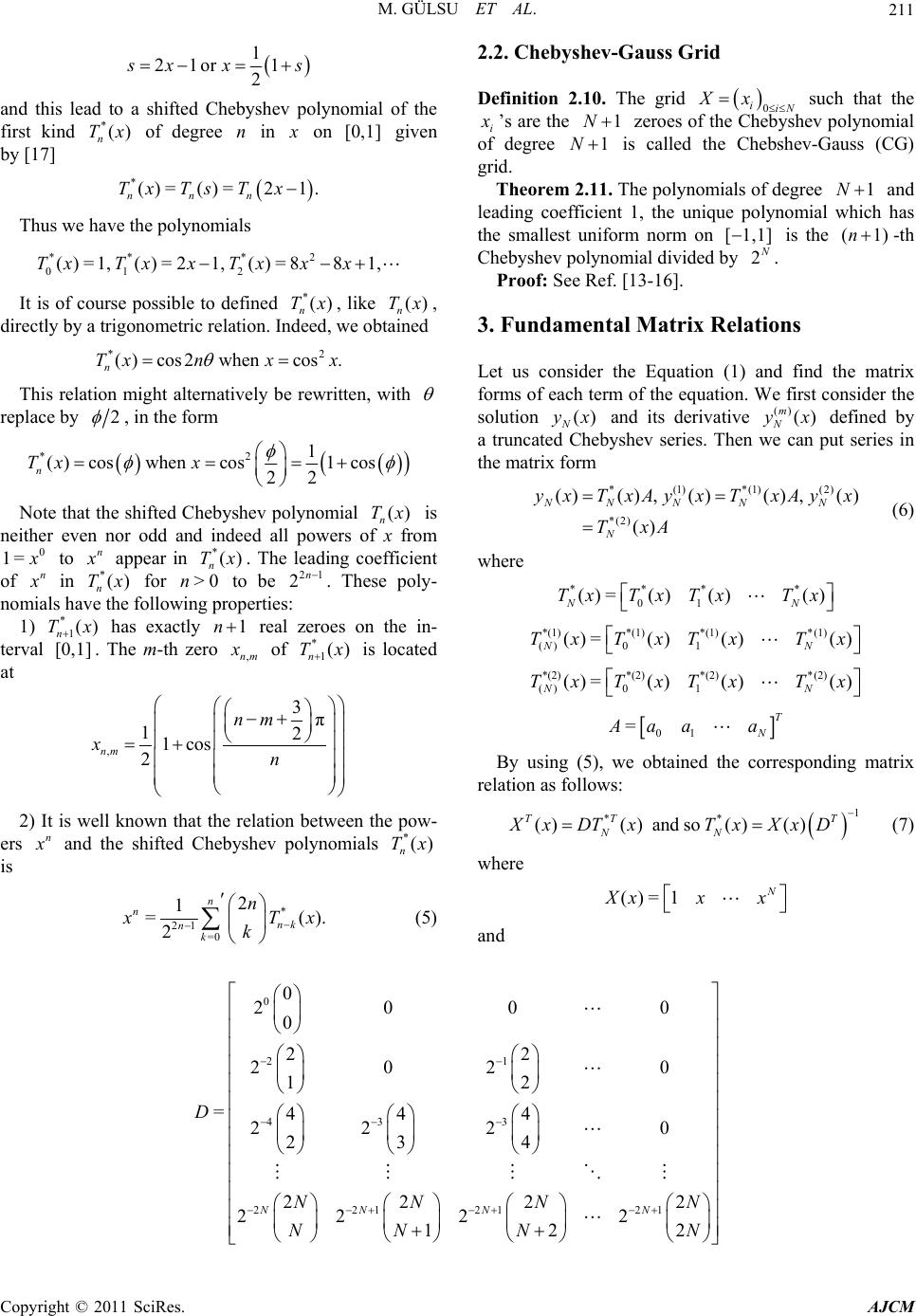 M. GÜLSU ET AL. Copyright © 2011 SciRes. AJCM 211 2.2. Chebyshev-Gauss Grid 1 21or1 2 xx s Definition 2.10. The grid 0 iiN such that the i Xx ’s are the 1N zeroes of the Chebyshev polynomial of degree 1N is called the Chebshev-Gauss (CG) grid. and this lead to a shifted Chebyshev polynomial of the first kind of degree in *() n Tx n on given by [17] [0,1] *()=()=21. nnn Tx TsTx Theorem 2.11. The polynomials of degree 1N and leading coefficient 1, the unique polynomial which has the smallest uniform norm on is the [1,1](n1) -th Chebyshev polynomial divided by . 2N Thus we have the polynomials ** *2 01 2 ()=1,()=2 1,()=88 1,TxTxx Txxx Proof: See Ref. [13-16]. It is of course possible to defined , like , directly by a trigonometric relation. Indeed, we obtained *() n Tx () n Tx 3. Fundamental Matrix Relations *2 ( )cos2whencos. n Txnx x This relation might alternatively be rewritten, with replace by 2 , in the form *2 1 ( )coswhencos1cos 22 n Tx x Let us consider the Equation (1) and find the matrix forms of each term of the equation. We first consider the solution and its derivative () N yx () () m N x defined by a truncated Chebyshev series. Then we can put series in the matrix form *(1)*(1)(2) *(2) ()() ,()() ,() () NN N NN N yx TxAyx TxAy x TxA (6) Note that the shifted Chebyshev polynomial is neither even nor odd and indeed all powers of x from () n Tx 0 1= to n appear in . The leading coefficient of *() n Tx n in for to be . These poly- nomials have the following properties: * n T()x>0n21 2nwhere *** * 01 ()= ()()() NN TxTx TxTx 1) has exactly * 1() n Tx 1n real zeroes on the in- terval . The m-th zero [0,1] ,nm of is located at * 1() n Tx *(1)*(1) *(1)*(1) () 01 ()= ()()() NN Tx TxTxTx *(2)*(2) *(2)*(2) () 01 ()= ()()() NN Tx TxTxTx , 3π 12 1cos 2 nm nm xn 01 =T N Aaa a By using (5), we obtained the corresponding matrix relation as follows: 1 ** ()()andso ()() TT NN Xx DT xTxXxD T (7) 2) It is well known that the relation between the pow- ers n and the shifted Chebyshev polynomials is *() n Tx where ()=1 N xxx * 21=0 2 1 = 2 n n nk n k n(). Tx k (5) and 0 21 43 3 221 2121 0 200 0 0 22 202 0 12 =44 4 22 20 23 4 22 2 22 22 12 NN NN D NN N NN N 2 2 N N 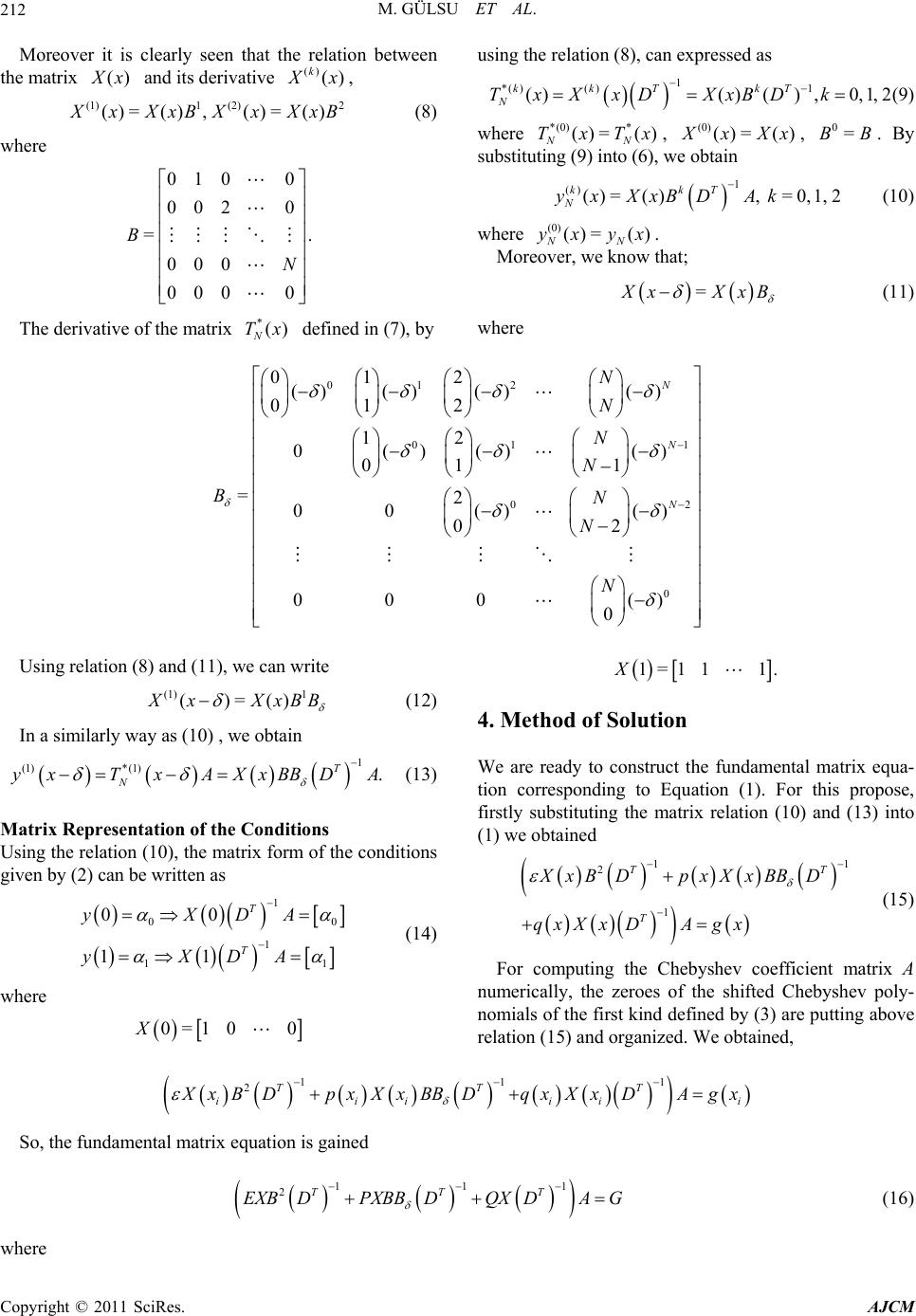 M. GÜLSU ET AL. 212 Moreover it is clearly seen that the relation between the matrix () x and its derivative () () k x, 1 (2)(1)2 ()= (),()= () xXxBXxXxB (8) where 010 0 002 0 =. 000 000 0 B N The derivative of the matrix defined in (7), by *() N Tx using the relation (8), can expressed as 1 *( )( )1 ()()() ,0,1,2 kkT kT N TxXxDXxBD k (9) where , *(0) * ()= () NN TxTx (0) ()= () xXx, . By substituting (9) into (6), we obtain 0=BB 1 () ()=(),=0,1,2 kkT N yxXxBD Ak (10) where (0) ()= () NN xyx. Moreover, we know that; = xXxB (11) where 01 2 01 02 0 012 () ()()() 012 12 0()() () 01 1 =2 00()() 02 000 () 0 N N N N N N N BN N N 1 Using relation (8) and (11), we can write (1) 1 ()=() xXxBB (12) In a similarly way as (10) , we obtain 1 (1) *(1). T N yxT xAXxBBD A (13) Matrix Representation of the Conditions Using the relation (10), the matrix form of the conditions given by (2) can be written as 1 00 1 11 00 11 T T yXDA yXDA (14) where 0=1 00X 1=1 11.X 4. Method of Solution We are ready to construct the fundamental matrix equa- tion corresponding to Equation (1). For this propose, firstly substituting the matrix relation (10) and (13) into (1) we obtained 11 2 1 TT T XxB DpxXxBB D qxX xDAgx (15) For computing the Chebyshev coefficient matrix A numerically, the zeroes of the shifted Chebyshev poly- nomials of the first kind defined by (3) are putting above relation (15) and organized. We obtained, 111 2TTT iii iii xBDpxXxBBDqxXxDA gx So, the fundamental matrix equation is gained 111 2TTT EXBDPXBBDQX DAG here (16) w Copyright © 2011 SciRes. AJCM 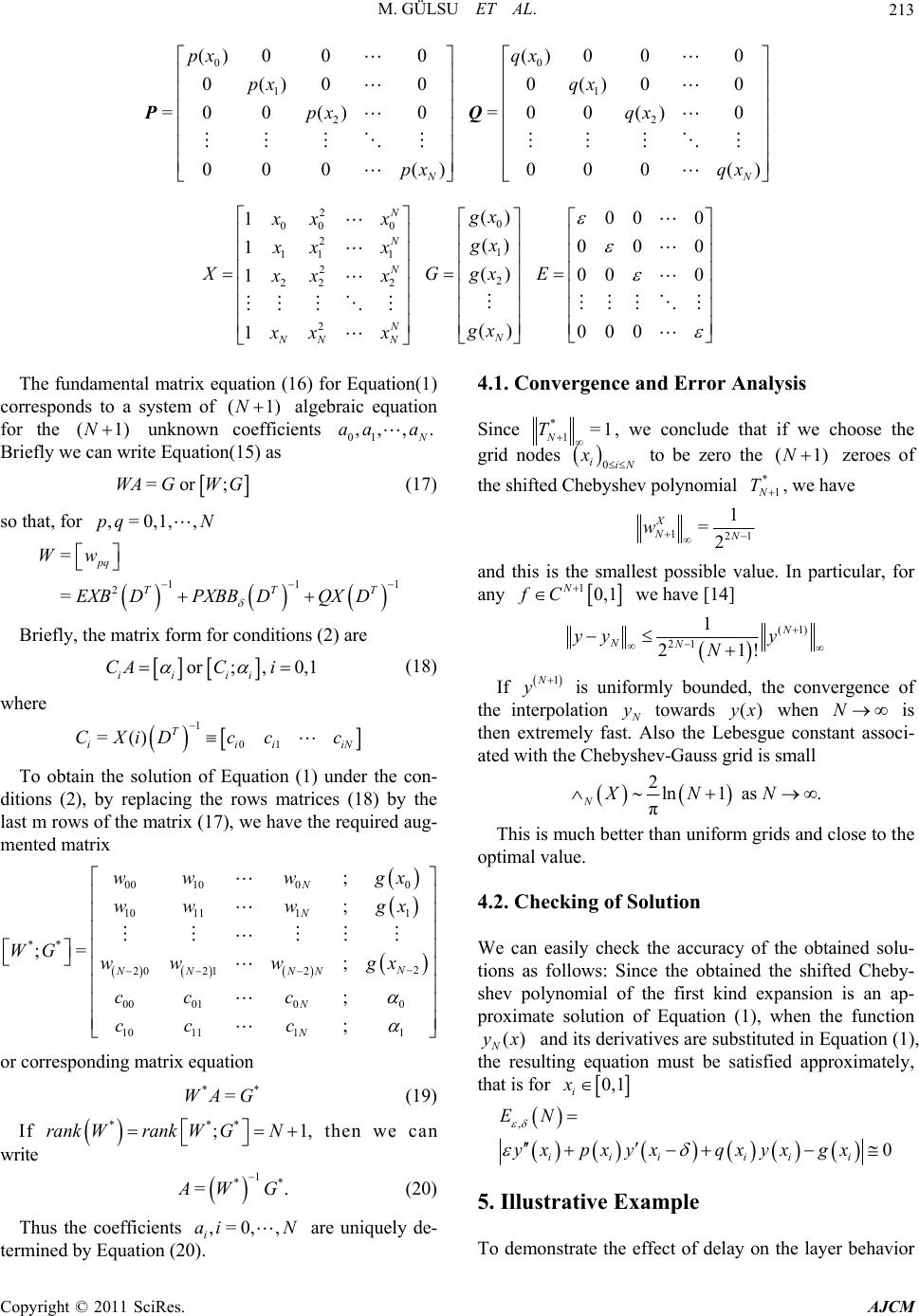 M. GÜLSU ET AL.213 0 00 11 22 ()000() 000 0()000()0 0 =00()0=00 ()0 000()0 00() NN px qx px qx px qx px qx PQ 2 0 00 0 2 1 11 1 2 2 222 2 () 00 0 1 () 00 1 () 00 0 1 () 000 1 N N N N N NN N gx xx x gx xx x XGgxE xx x gx xx x The fundamental matrix equation (16) for Equation(1) corresponds to a system of (1)N algebraic equation for the (1)N unknown ients 01 ,, ,.coeffic aa a Briefly weite Equation(15) as can wr =or ;WAGWG (17) so that, for 1 T Briefly, the matrix form for conditions (2) are ,=0,1,,pq N 11 2 = pq TT EXB DPXBBDQXD =Ww or; ,0,1 ii ii CACi (18) where 1 01 =()T iii CXiDc cc iN To obtain the solution of Equation (1) underthe con- di tions (2), by replacing the rows matrices (18) by the last m rows of the matrix (17), we have the required aug- mented matrix 00 1000 10 1111 ** 2 20 212 00 0100 10 1111 ; ; ;= ; ; ; N N N NN NN N N w gx wwwgx WG www gx cc c cc c ww or corresponding matrix equation (19) If ** =WA G *** ; rank WrankWGN w , then we can rite 1 ** =. WG (20) Thus the coefficients are uniquely de- termined by Equation (2 4.1. Convergence and Error Analysis ,=0, , i ai N 0). Since * 1=1 N T, we conc grid nodes lude that if we choose the 0 iiN x to be zero the (1N) zeroes of hebysthe shifted Chev polynomial 1N T, we have * 121 1 = X NN w 2 and this is the smallest possible value. particular, In for any 10,1 N fC we have [14] (1) 21 21 ! N NN yy y N 1 If 1N y the interpolation is uniformly bounded, the convence of erg towards () x besgue y when is then eely fastAlso the Le co atith th nstant associ- N xtrem. ed we Chebyshev-Gauss grid is small 2ln1as. π NXNN This is much better than uniform grids and close to the optimal value. 4. We can easily check the accuracy of the obtained solu- tained the shifted Cheby- shev polynomial of the first kind expansion is an ap- 2. Checking of Solution tions as follows: Since the ob proximate solution of Equation (1), when the function () N yx and its derivatives are substituted in Equation (1), the resulting equation must be satisfied approximately, that is for 0,1 i x , i EN yx x 0 ii iii pxyqxyx gx 5. Illustrative Example To demonstrate the effect of delay on the layer behavior Copyright © 2011 SciRes. AJCM 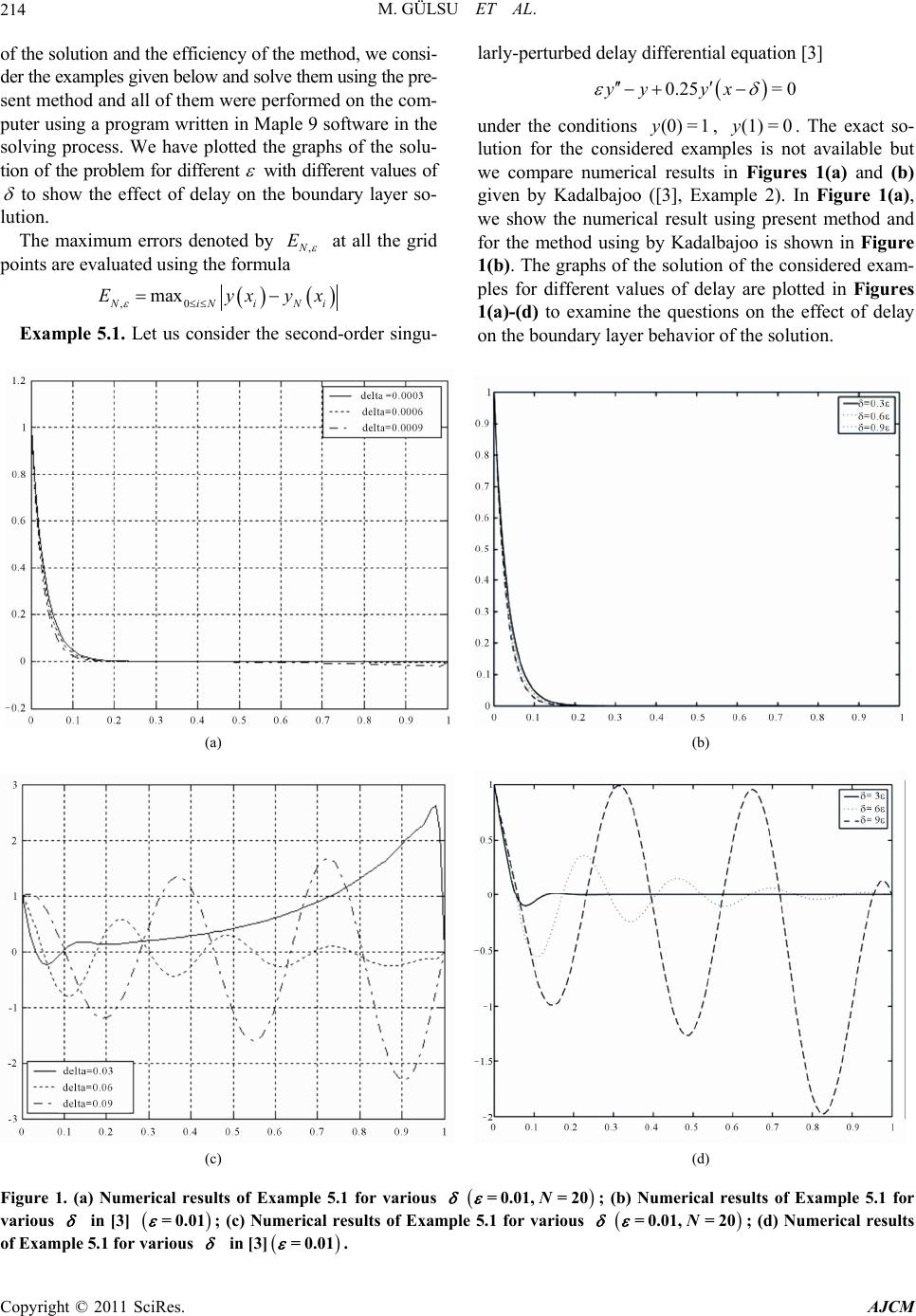 M. GÜLSU ET AL. 214 of the method, we consi- der the examples given below and solve them using the pre- of the solution and the efficiency sent method and all of them were performed on the com- puter using a program written in Maple 9 software in the solving process. We have plotted the graphs of the solu- tion of the problem for different with different values of to show the effect of delay on the boundary layer so- lution. The maximum errors denotedy ,N E b at all the grid ints are evaluated using the formula po ,0 max iN ii Eyx Example 5.1. Let us consider the sec N yx ond-order singu- la under the conditions lution for the considered examples is not available but l resultFigur rly-perturbed delay differential equation [3] 0.25=0yy yx (0)= 1y, (1)= 0y. The exact so- we compare numericas in es 1(a) and (b) given by Kadalbajoo ([3], Example 2). In Figure 1(a), we show the numerical result using present method and for the method using by Kadalbajoo is shown in Figure 1(b). The graphs of the solution of the considered exam- ples for different values of delay are plotted in Figures 1(a)-(d) to examine the questions on the effect of delay on the boundary layer behavior of the solution. (a) (b) (c) (d) Figure 1. (a) Numerical results of Example 5.1 for various = 0.01,= 20 N; (b) Numerical results of Example 5.1 for various in [3] =0.01 ; (c) Numerical results of Example 5.1 for various = 0.01,= 20 N; (d) Numerical results of Example 5.1 for various in [3] =0.01 . Copyright © 2011 SciRes. AJCM 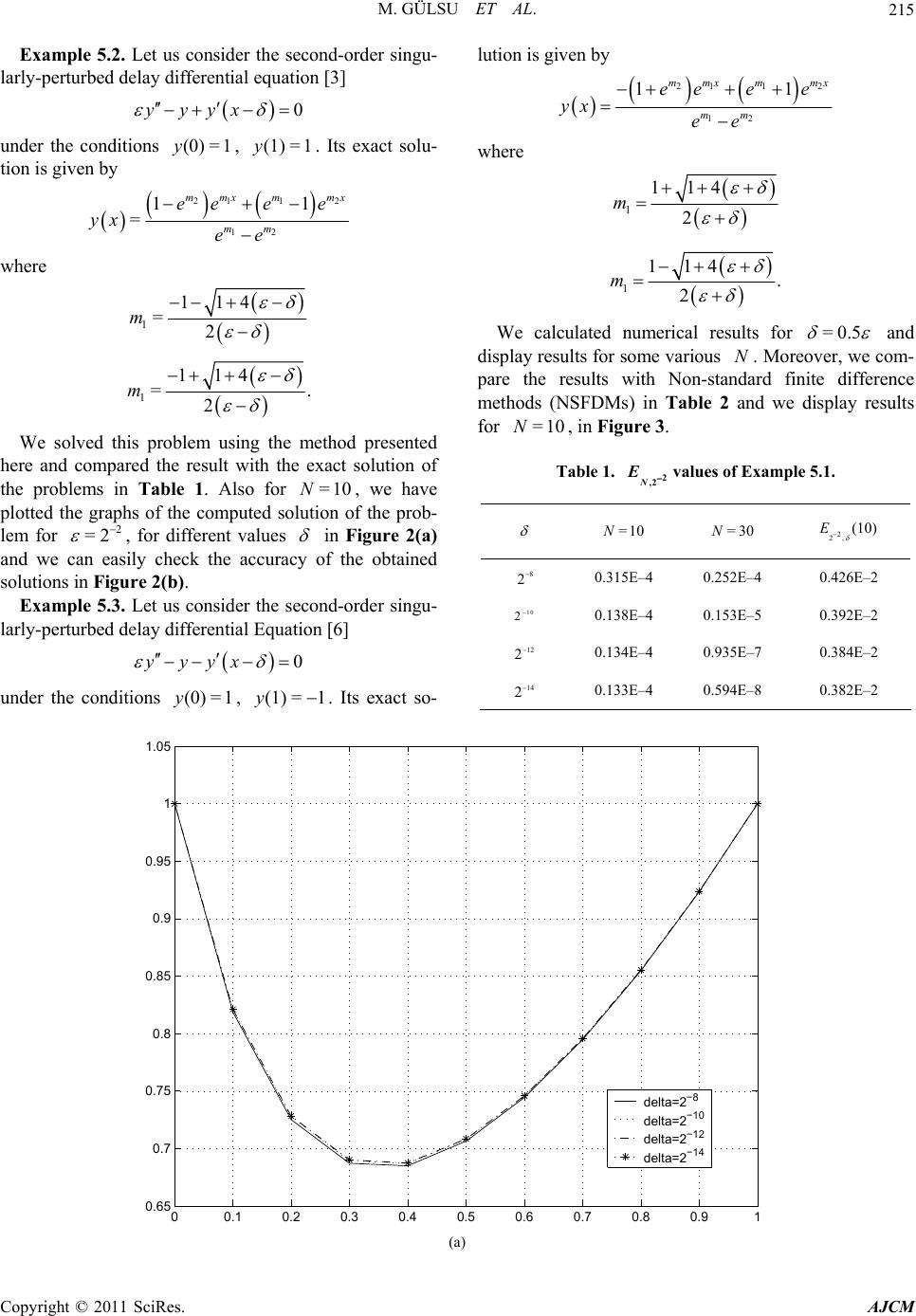 M. GÜLSU ET AL.215 nse seconder singu- under the conditions . Its exact solu- Example 5.2. Let us coider th-ord larly-perturbed delay differential equation [3] 0yyyx (0)= 1y, (1)= 1y tion is given by 21 12 12 11 = mmx mmx mm ee ee yx ee where 1 114 =2 m 1 114 =. 2 m We solved this problem using the method presented here and compared the result with the exact solution of the problems in Table 1. Also for =10N, we have plotted the graphs of the computed solutiof the prob- lem for 2 =2 , for different values n o in Figure 2(a) and we casily check the accuracy of the obtained solutions in Figure 2(b) . Example 5.3. Let us consider the second-order singu- la n ea rly-perturbed delay differential Equation [6] 0yyyx under the conditions . Its exact so- lution is given by (0)= 1y, (1) =1y 21 12 12 11 mmx mmx mm ee ee yx ee where 1 114 2 m 1 114 . 2 m We calculated numerical results for =0.5 and di Table 1. splay results for some various N. Moreover, we com- pare the results with Non-standard finite difference methods (NSFDMs) in Table 2 and we display results for =10N, in Figure 3. 2 ,2 N Evalues of Example 5.1. =10N =30N 2 2, (10)E 8 2 0.315E–4 0.252E–4 0.426E–2 10 2 0.138E–4 0.153E–5 0.392E–2 12 2 0.134E–4 0.935E–7 0.384E–2 14 2 0.133E–4 0.594E–8 0.382E–2 00.10.20.3 0.4 0.50.60.7 0.80.91 0.65 0.7 0.75 0.8 0.85 0.9 0.95 1 1.05 delta=2 −8 delta=2 −10 delta=2 −12 delta=2 −14 (a) Copyright © 2011 SciRes. AJCM 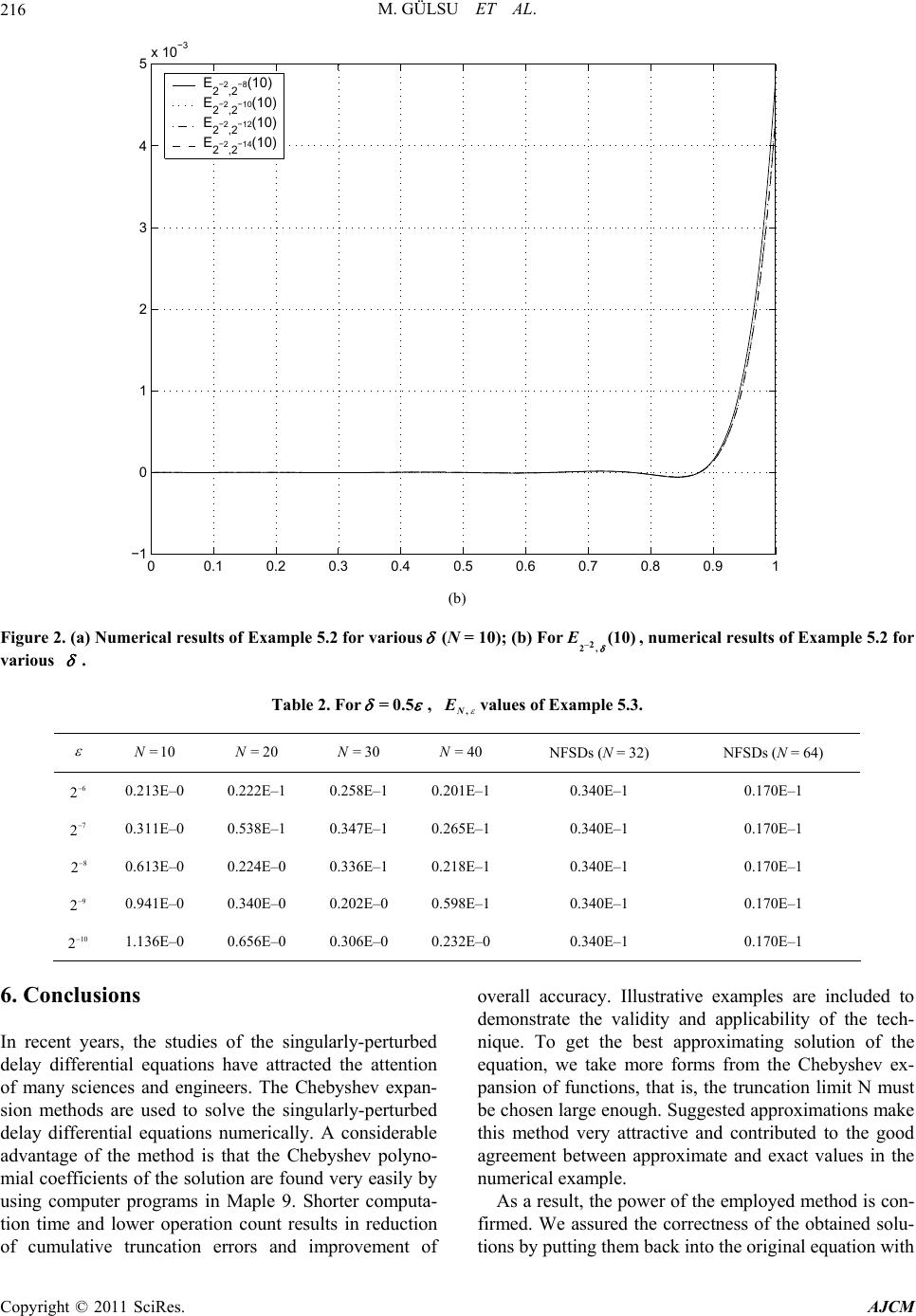 M. GÜLSU ET AL. 216 00.1 0.2 0.3 0.4 0.5 0.60.70.8 0.9 1 0 1 2 3 4 5x 10 E 2 −2 ,2 −8(10) E 2 −2 ,2 −10(10) E 2 −2 ,2 −12(10) E 2 −2 ,2 −14(10) (b) Figure 2. (a) Numerical results of Example 5.2 for various(N = 10); (b) For, numerical results of Example 5.2 for 2 2,(10)E various . Table 2. For=0.5 , ,N Evalues of Example 5.3. =10N =2N0 =3N NFSDs (N = 32) 0 =40NNFSDs (N = 64) 6 2 0.213E–0 0.222E–1 0.258E–1 0.201E–1 0.340E–1 0.170E–1 7 2 0.311E–0 0.538E–1 0.347E–1 0.265E–1 0.340E–1 0.170E–1 8 2 0.613E–0 0.224E–0 0.336E–1 0.218E–1 0.340E–1 0.170E–1 9 2 0.941E–0 0.340E–0 0.202E–0 0.598E–1 0.340E–1 0.170E–1 10 2 1.136E–0 0.656E–0 0.306E–0 0.232E–0 0.340E–1 0.170E–1 studies of the singularly-perturbed overall accuracy. Illustrative examples are included to tions by putting them back into the original equation with 6. Conclusions In recent years, the delay differential equations have attracted the attention of many sciences and engineers. The Chebyshev expan- sion methods are used to solve the singularly-perturbed delay differential equations numerically. A considerable advantage of the method is that the Chebyshev polyno- mial coefficients of the solution are found very easily by using computer programs in Maple 9. Shorter computa- tion time and lower operation count results in reduction of cumulative truncation errors and improvement of demonstrate the validity and applicability of the tech- nique. To get the best approximating solution of the equation, we take more forms from the Chebyshev ex- pansion of functions, that is, the truncation limit N must be chosen large enough. Suggested approximations make this method very attractive and contributed to the good agreement between approximate and exact values in the numerical example. As a result, the power of the employed method is con- firmed. We assured the correctness of the obtained solu- Copyright © 2011 SciRes. AJCM 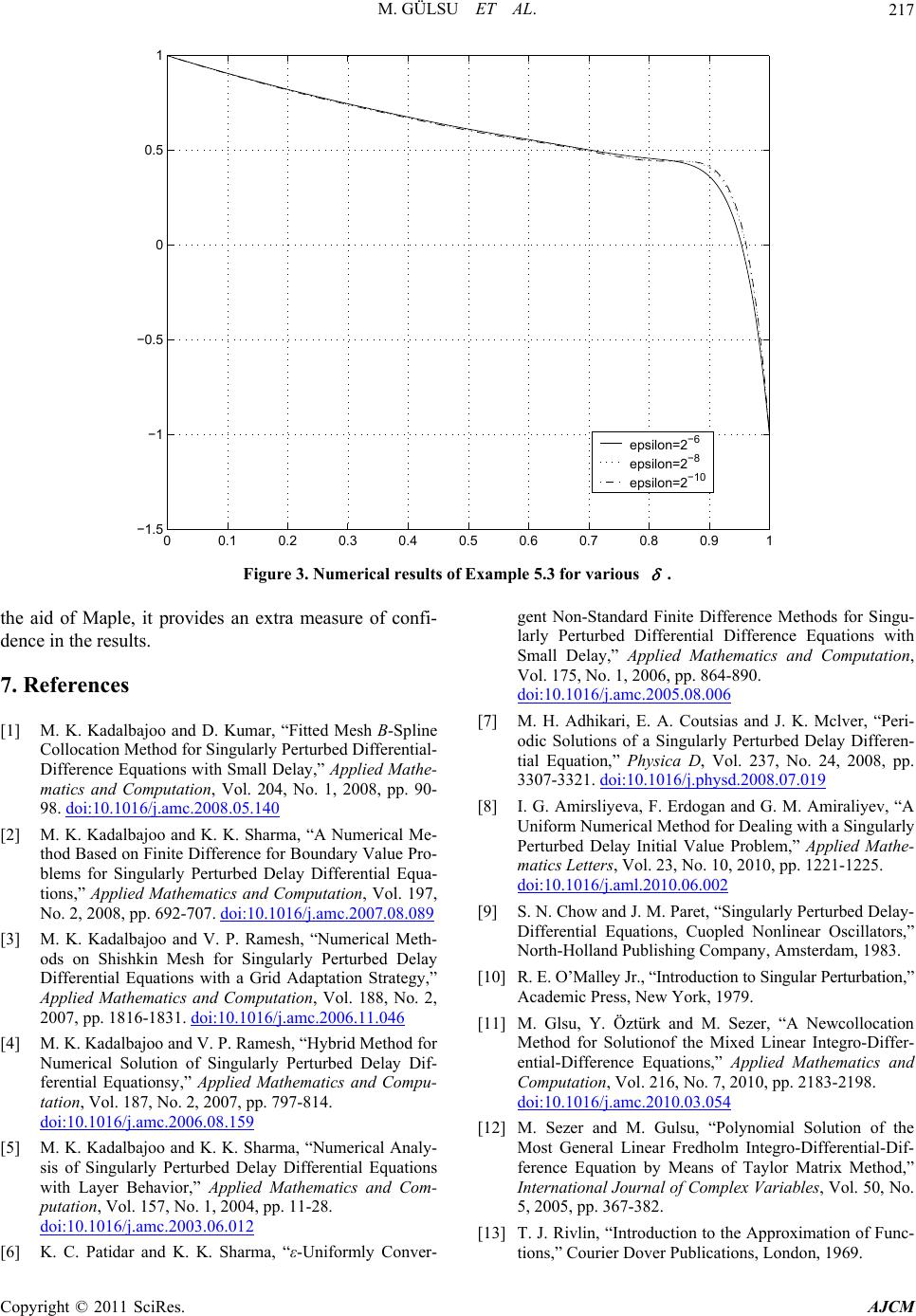 M. GÜLSU ET AL.217 00.1 0.2 0.3 0.40.5 0.6 0.7 0.8 0.9 1.5 −1 0.5 0 0.5 1 epsilon=2 −6 epsilon=2 −8 epsilon=2 −10 Figure 3. Numerical results of Example 5.3 for various . the aid of Maple, it provides an extra measure of confi- dence in the results. Kumar, “Fitted Mesh B-Spline ethod for Singularly Perturbed Differential- ations with Small Delay,” Applied Mathe- 7. References [1] M. K. Kadalbajoo and D. Collocation M Difference Equ matics and Computation, Vol. 204, No. 1, 2008, pp. 90- 98. doi:10.1016/j.amc.2008.05.140 [2] M. K. Kadalbajoo and K. K. Sharma, “A Numerical Me- thod Based on Finite Difference for Boundary Value Pro- blems for Singularly Perturbed Delay Differential Equa- tions,” Applied Mathematics and Computation, Vol. 197, No. 2, 2008, pp. 692-707. doi:10.1016/j.amc.2007.08.089 [3] M. K. Kadalbajoo and V. P. Ramesh, “Numerical Meth- ods on Shishkin Mesh for Singularly Perturbed Delay Differential Equations with a Grid Adaptation Strategy,” Applied Mathematics and Computation, Vol. 188, No. 2, 2007, pp. 1816-1831. doi:10.1016/j.amc.2006.11.046 [4] M. K. Kadalbajoo and V. P. Ramesh, “Hybrid Method for Numerical Solution of Singularly Perturbed Delay Dif- ferential Equationsy,” Applied Mathematics and Compu- tation, Vol. 187, No. 2, 2007, pp. 797-814. doi:10.1016/j.amc.2006.08.159 [5] M. K. Kadalbajoo and K. K. Sharma, “Numerical Analy- sis of Singularly Perturbed Delay Differential Equations with Layer Behavior,” Applied Mathematic putation, Vol. 157, No. 1, 2004, s and Com- pp. 11-28. doi:10.1016/j.amc.2003.06.012 [6] K. C. Patidar and K. K. Sharma, “ε-Uniformly Conver- Vol. 175, No. 1, 2006, pp. 864-890. gent Non-Standard Finite Difference Methods for Singu- ffntial Difference Equations with li Mathematics and Computation, larly Perturbed Diere Small Delay,” App ed doi:10.1016/j.amc.2005.08.006 [7] M. H. Adhikari, E. A. Coutsias and J. K. M odic Solutions of a Singularly P clver, “Peri- erturbed Delay Differen- tial Equation,” Physica D, Vol. 237, No. 24, 2008, pp. 3307-3321. doi:10.1016/j.physd.2008.07.019 [8] I. G. Amirsliyeva, F. Erdogan and G. M. Amiraliyev, “A Uniform Numerical Method for Dealing with a Singularly Perturbed Delay Initial Value Problem,” Applied Mathe- matics Letters, Vol. 23, No. 10, 2010, pp. 1221-1225. doi:10.1016/j.aml.2010.06.002 [9] S. N. Chow and J. M. Paret, “Singularly Perturbed Delay- Differential Equations, Cuopled Nonlinear Oscillators,” North-Holland Publishing Company, Amsterdam, 1983. [10] R. E. O’Malley Jr., “Introduction to Singular Perturbation,” Academic Press, New York, 1979. [11] M. Glsu, Y. Öztürk and M. Sezer, “A Newcollocatio Method for Solutionof the Mix n ed Linear Integro-Differ- ential-Difference Equations,” Applied Mathematics and Computation, Vol. 216, No. 7, 2010, pp. 2183-2198. doi:10.1016/j.amc.2010.03.054 [12] M. Sezer and M. Gulsu, “Polynomial Solution of the Most General Linear Fredholm Integro-Differential-Dif- ference Equation by Means of Taylor Matrix Method,” International Journal of Complex Variables, Vol. 50, No. 5, 2005, pp. 367-382. [13] T. J. Rivlin, “Introduction to the Approximation of Func- tions,” Courier Dover Publications, London, 1969. Copyright © 2011 SciRes. AJCM 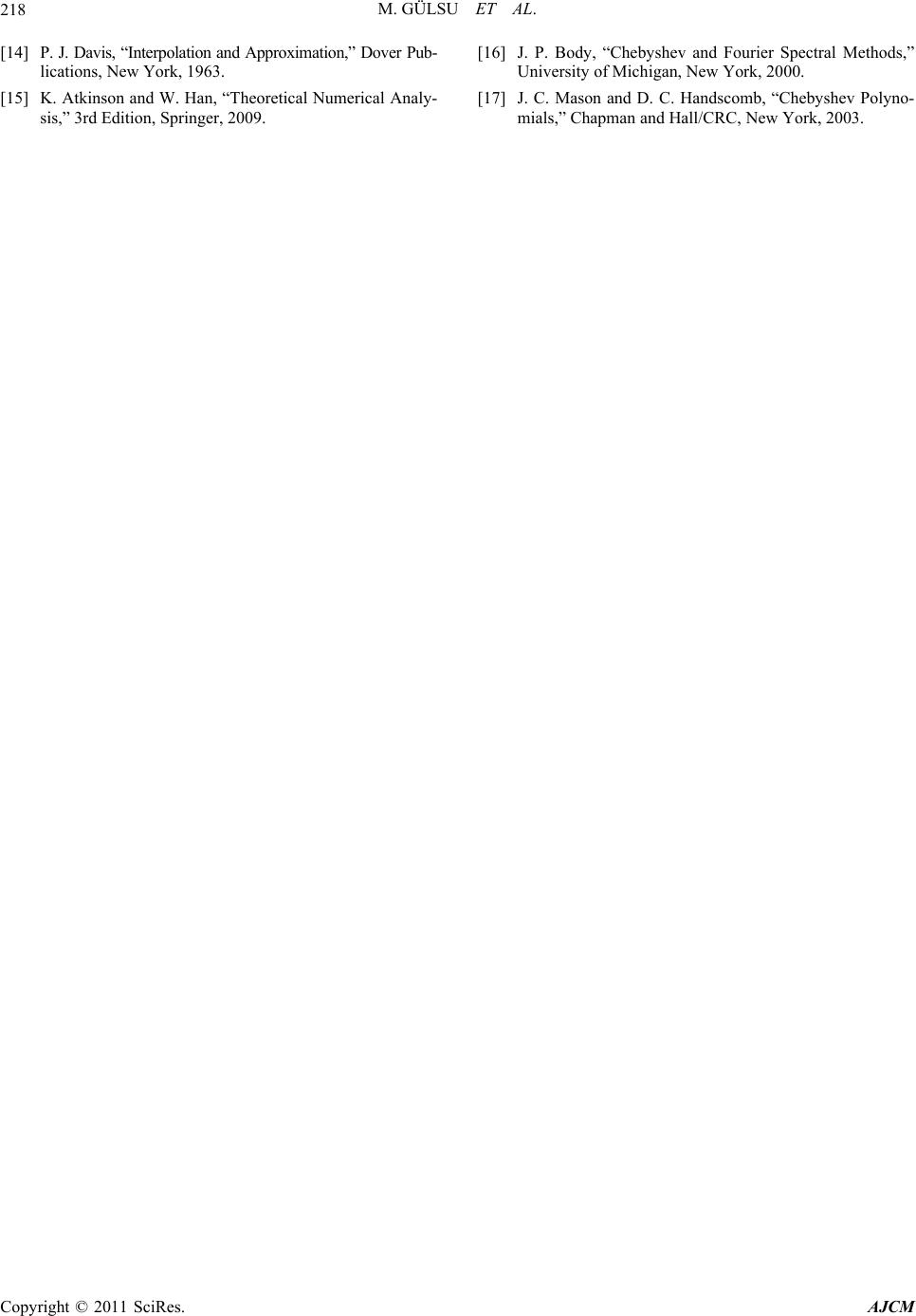 M. GÜLSU ET AL. 218 proximation,” Dover Pub- and Fourier Spectral Methods,” yno- mials,” Chapman and Hall/CRC, New York, 2003. [14] P. J. Davis, “Interpolation and Ap lications, New York, 1963. [15] K. Atkinson and W. Han, “Theoretical Numerical Analy- sis,” 3rd Edition, Springer, 2009. [16] J. P. Body, “Chebyshev University of Michigan, New York, 2000. 7] J. C. Mason and D. C. Handscomb, “Chebyshev Pol[1 Copyright © 2011 SciRes. AJCM
|